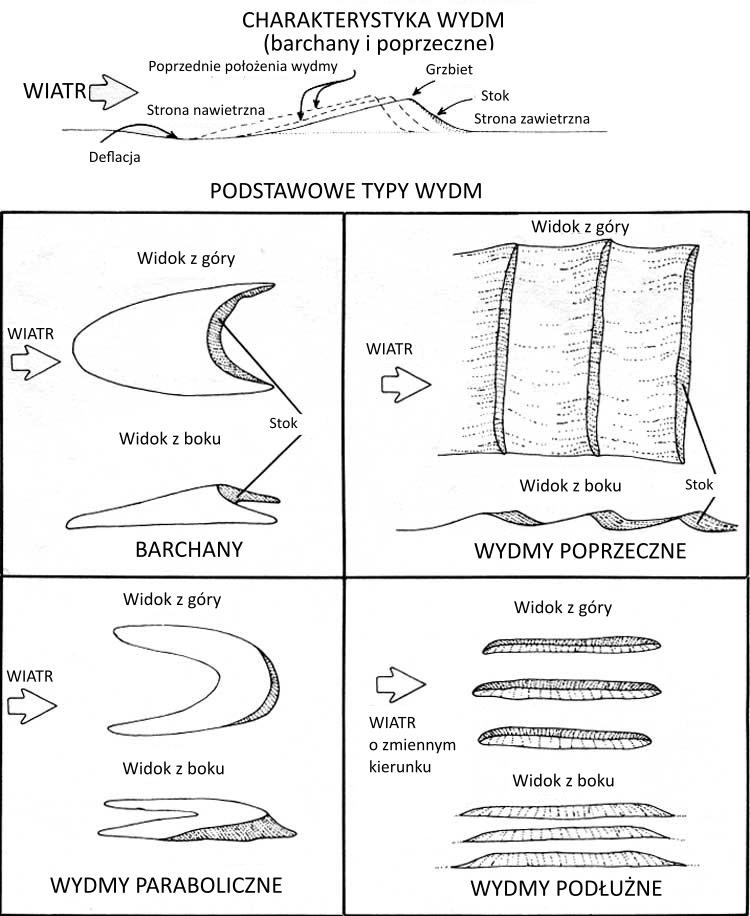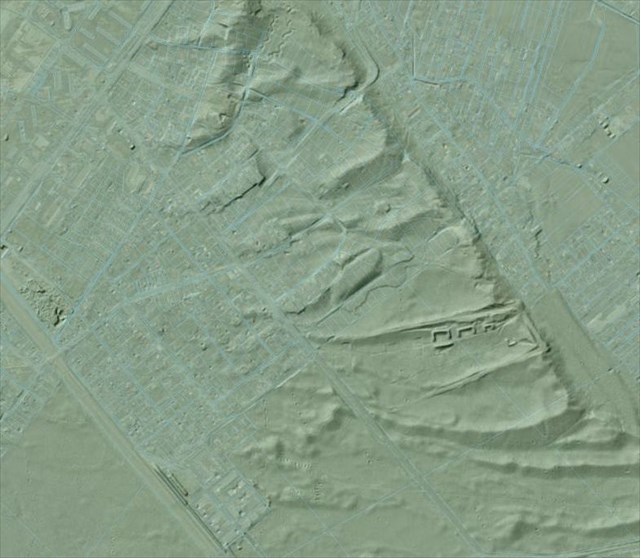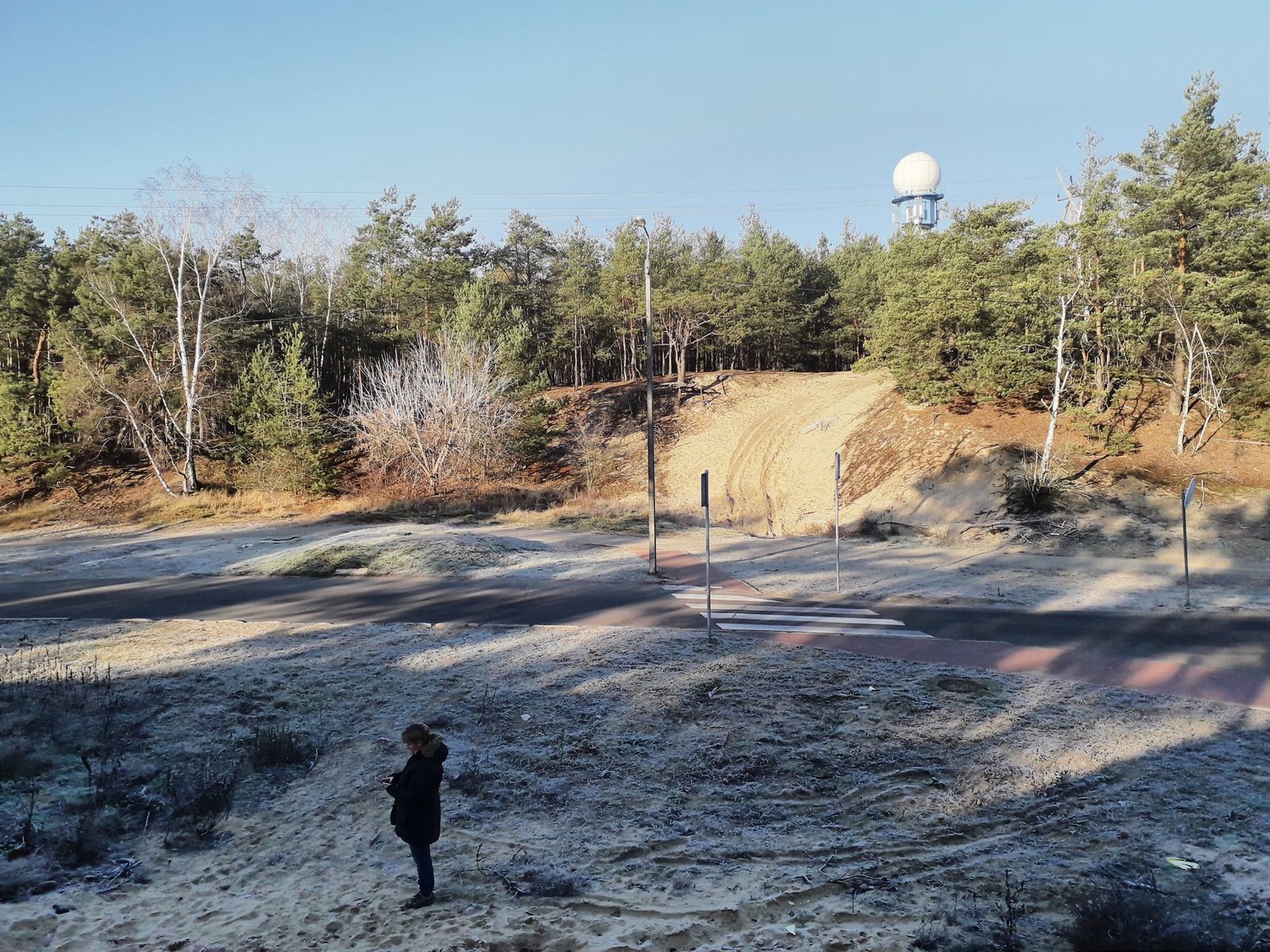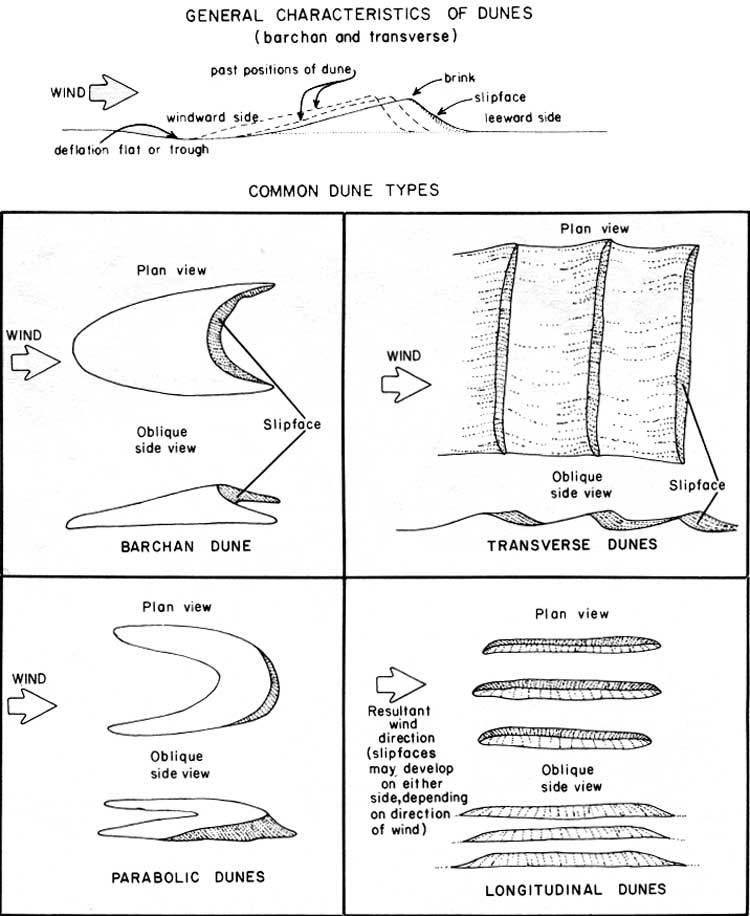[PL]
Rejon Legionowa w czasie ostatniego zlodowacenia bałtyckiego znalazł się poza zasięgiem lodowca, około 100 km na południe od jego czoła. Co nie znaczy, że lodowce w czwartorzędzie tu nie występowały - obszar ten znalazł się w zasięgu wcześniejszego zlodowacenia południowopolskiego i środkowopolskiego.
Na powierzchni terenu w interesującym nas rejonie występują najmłodsze osady plejstoceńskie oraz jeszcze młodsze holoceńskie o stosunkowo małej miąższości. Są to piaski i mady tarasów rzecznych, piaski eoliczne (czyli powstałe w wyniku działalności wiatru), często tworzące wydmy oraz podrzędnie torfy i namuły torfiaste.
Depozycja materiału osadowego pod działaniem wiatru znana jest pod nazwą akumulacji eolicznej. Wiatr, podobnie jak i woda, może tworzyć wydmy, przy czym siła wody jest większa i na wydmach eolicznych nie spotkamy cięższego materiału osadowego. Stąd są to głównie wydmy piaskowe o rozmaitym kształcie. Warto pamiętać, że wydmy tworzą się zarówno w klimacie suchym, jak i wilgotnym.

Wydmy i ich rodzaje: barchany, poprzeczne, paraboliczne, podłużne
Mechanizm powstawania wydmy związany jest z zatrzymywaniem się piasku wleczonego wiatrem lub zalegającego blisko ziemi na przeszkodach jak głazy, roślinność i inne przeszkody terenowe. Powstaje wtedy wydma o łagodnym zboczu skierowanym w stronę wiatru i stromym od strony przeciwnej. Piasek przesypując się przez górę wyniosłości zsuwa się w dół lub zostaje wywiany i tak oto wydma staje się wędrująca.
Wydmy układają się równolegle albo prostopadle do kierunku wiatru. Klasyczne wydmy o sierpowatym kształcie skierowane czołem do kierunku wiatru nazywamy barchanami. Inne typy wydm to poprzeczne (poprzeczne do kierunku wiatru), podłużne (zgodne z kierunkiem wiatru i wydłużone w jego kierunku) i paraboliczne (wygięte łukowato, przy czym środek wydmy jest najdalej wysunięty - przeciwnie niż przy barchanach). Mogą jednak wystąpić obszary, gdzie wiatry mają kierunek zmienny i wtedy spotkamy wydmy w formie pagórków.

Wydmy legionowskie na zdjęciach LIDAR
Barchany powstają, gdy materiału jest mało, a wiatr umiarkowany; wydmy poprzeczne, gdy materiału jest dużo, a wiatry silne; wydmy podłużne i paraboliczne, gdy materiału jest dużo, a wiatry silne.
Osady eolityczne mają też jeszcze jedną cechę, bardzo pożądaną w pewnych zastosowaniach - a mianowicie jednorodność. Ziarna piasku toczone przez wiatr nie posiadają warstewki ochronnej jak w wodzie i ulegają silniejszemu ścieraniu - stąd są bardziej starte i porysowane niż rzeczne. Wiatr odpowiada też za wywiewanie lżejszych minerałów i skład takiego piachu jest bardziej jednorodny.

Droga przez wydmę
Pytania:
1. Popatrz na wydmy w tym miejscu i na ich kształt - twoim zdaniem jakie wiatry ją ukształtowany i czy z dużej ilości materiału czy z małej (opis)? Określ kierunek wiatru, który tu przeważał.
2. Popatrz po obydwu stronach ulicy przebitej przez wydmę - po prawej i po lewej stronie, widzisz profil wydmy. Z której strony jest ona bardziej stroma (wschód, zachód)?
3. Weź do ręki garść piachu. Obejrzyj go dokładnie.
a) czy ten piasek jest jednorodny? czy zdarzają się tu większe kamienie? To jest piasek drobny czy gruby? Oceń orientacyjnie procentowo.
b) czy widzisz w jego składzie jakieś ziarna innego koloru niż typowy dla piasków kwarcowych? Jaki?
c) odłóż garść piachu na miejsce - czy przypadkiem na twojej dłoni coś nie zostało? Czy łatwo się tego pozbyć? O czym to świadczy?
4. Zdjęcie twoje lub jakiegoś przedmiotu cię identyfikujacego w takiej piaskownicy - marzenie dzieciństwa. Nie krępuj się i zamieść w logu.
 [PL]
[PL]
Skrzynka typu EarthCache, nie posiada fizycznego pojemnika. Aby zalogować znalezienie tego EarthCache, musisz udać się pod wskazane współrzędne, odpowiedzieć na powyższe pytania.
Odpowiedzi proszę wysyłać za pomocą mojego profilu. Nie trzeba czekać na moją odpowiedź, można od razu logować. Jeśli coś będzie nie tak, zgłoszę się sam. W razie potrzeby pomogę w rozwiązaniu zadań. Logi bez podesłanych odpowiedzi będą kasowane.
[EN]
The Legionowo area during the last Baltic glaciation was beyond the range of the glacier, about 100 km south of its forehead. This does not mean that there were no glaciers in the Quaternary - this area was within the range of earlier southern and central Polish glaciation.
Deposition of sedimentary material under the action of wind is known as aeolian accumulation. Wind, like water, can create dunes, but the water strength is greater and in the Aeolian dunes we will not find heavier sedimentary material. Hence, they are mainly sand dunes of various shapes. It is worth remembering that dunes are formed in both dry and humid climates.

Dunes and their types: barchans, transverse, parabolic, longitudinal
The mechanism of the formation of the dune is associated with the stopping of sand dragged by the wind or lying close to the ground on obstacles such as boulders, vegetation and other terrain obstacles. A dune arises with a gentle slope directed towards the wind and steep from the opposite side. Sand pouring through the top of the dune slides down or is blown away and thus the dune becomes moving.
The dunes are parallel or perpendicular to the wind direction. Classical sickle-shaped dunes facing the wind are called barchans. Other types of dunes are transverse (transverse to the direction of the wind), longitudinal (consistent with the direction of the wind and elongated in its direction) and parabolic (arched, the middle of the dune is the farthest part - opposite to the barchans). However, there may be areas where the winds have a variable direction and then we will meet dunes in the form of hills.

Legionowo dunes in the LIDAR pictures
Barchans are formed when the material is scarce and the wind is moderate; transverse dunes, when there is a lot of material and strong winds; longitudinal and parabolic dunes when there is a lot of material and strong winds.
Eolithic deposits also have one more feature that is very desirable in certain applications - namely homogeneity. Sand grains turned by the wind do not have a protective film like in water and are subject to stronger abrasion - hence they are more worn and scratched than river. The wind is also responsible for blowing out lighter minerals and the composition of such sand is more homogeneous.
Tasks:
1. Look at the dunes here and their shape - in your opinion, what winds shaped it and whether from a large amount of material or from a small (description)? Determine the wind direction that prevailed here.
2. Look on both sides of the street pierced by the dune - on the right and left you can see the profile of the dune. Which side is it steeper (east, west)?
3. Take a handful of sand. Watch it carefully.
a) Is this sand homogeneous? Are there bigger stones here? Is it fine or coarse sand? Estimate by percentage.
b) Do you see in its composition any grains of a different color than typical for quartz sands? What color?
c) Put a handful of sand back - is there something left on your palm? Is it easy to get rid of it? What does this mean?
4. Picture of you or something that identifies you in such a sandbox - childhood dream. Feel free to post it in the log.
 [EN]
[EN]
EarthCache not have a physical container. To log in finding EarthCache, you must go to the provided coordinates and answer these questions.
Please send answers via my profile. No need to wait for my answer, you can immediately log. If something is wrong, I will send you a message. If you need help in solving tasks just ask me. Logs without answers will be deleted.
